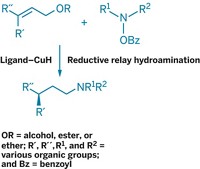Advertisement
Grab your lab coat. Let's get started
Welcome!
Welcome!
Create an account below to get 6 C&EN articles per month, receive newsletters and more - all free.
It seems this is your first time logging in online. Please enter the following information to continue.
As an ACS member you automatically get access to this site. All we need is few more details to create your reading experience.
Not you? Sign in with a different account.
Not you? Sign in with a different account.
ERROR 1
ERROR 1
ERROR 2
ERROR 2
ERROR 2
ERROR 2
ERROR 2
Password and Confirm password must match.
If you have an ACS member number, please enter it here so we can link this account to your membership. (optional)
ERROR 2
ACS values your privacy. By submitting your information, you are gaining access to C&EN and subscribing to our weekly newsletter. We use the information you provide to make your reading experience better, and we will never sell your data to third party members.
Synthesis
Extending Aminations’ Reach
Duo of transition-metal-free techniques add to the tool kit for making carbon-nitrogen bonds
by Carmen Drahl
November 5, 2012
| A version of this story appeared in
Volume 90, Issue 45
Two teams have independently developed reactions that convert boron-functionalized starting materials to amines without using transition-metal catalysts (J. Am. Chem. Soc., DOI: 10.1021/ja309637r and 10.1021/ja305448w). Alkyl- and arylamines are important reagents for pharmaceuticals and agrochemicals. Multiple transformations arrive at these amines, but they can require costly removal of metal contaminants or aren’t compatible with certain substrates. László Kürti of the University of Texas Southwestern Medical Center, Daniel H. Ess of Brigham Young University, and colleagues use O-(2,4-dinitrophenyl)hydroxylamine to obtain multigram quantities of primary aromatic amines directly from aryl boronic acids. The team’s calculations suggest that the amination proceeds through an aryl migration mechanism. Meanwhile, James P. Morken of Boston College and coworkers combine methoxyamine and n-butyllithium to obtain amines from pinacol boronates. Pinacol boronates are more stable than many boron reagents but typically aren’t compatible with aminations. The Boston team’s reaction, in contrast, works with aryl and alkyl pinacol boronates. It proceeds at gram scales and retains stereochemistry at the carbon adjacent to the amine nitrogen.





Join the conversation
Contact the reporter
Submit a Letter to the Editor for publication
Engage with us on Twitter